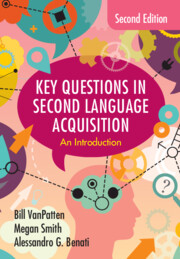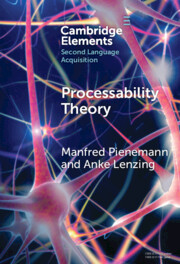Refine search
Actions for selected content:
133 results
The contribution of board games to vocabulary acquisition in the college Latin classroom
-
- Journal:
- Journal of Classics Teaching , First View
- Published online by Cambridge University Press:
- 14 November 2025, pp. 1-4
-
- Article
-
- You have access
- Open access
- HTML
- Export citation
11 - Factors in Variable Outcomes in Second Language Acquisition
- from Part IVA - Building Cognitive Brain Reserve and the Importance of Proficiency
-
-
- Book:
- The Cambridge Handbook of Language and Brain
- Published online:
- 12 December 2025
- Print publication:
- 09 October 2025, pp 262-309
-
- Chapter
- Export citation
12 - Longitudinal fMRI Analyses of Second Language Acquisition
- from Part IVA - Building Cognitive Brain Reserve and the Importance of Proficiency
-
-
- Book:
- The Cambridge Handbook of Language and Brain
- Published online:
- 12 December 2025
- Print publication:
- 09 October 2025, pp 310-338
-
- Chapter
- Export citation
Chapter 1 - Can We Have a Word?
- from Part I - Communicating in English
-
- Book:
- Lost in Automatic Translation
- Published online:
- 08 October 2025
- Print publication:
- 21 August 2025, pp 5-21
-
- Chapter
- Export citation
4 - The Acquisition of Scottish Gaelic Phonology
- from Part II - Acquisition of Phonology and Phonetics
-
-
- Book:
- The Acquisition of Celtic Languages
- Published online:
- 03 July 2025
- Print publication:
- 10 July 2025, pp 69-89
-
- Chapter
- Export citation
6 - Acquisition of Welsh Phonology
- from Part II - Acquisition of Phonology and Phonetics
-
-
- Book:
- The Acquisition of Celtic Languages
- Published online:
- 03 July 2025
- Print publication:
- 10 July 2025, pp 109-130
-
- Chapter
- Export citation
23 - Task-Based Language Teaching
- from Part V - Practice
-
-
- Book:
- The Cambridge Handbook of Technology in Language Teaching and Learning
- Published online:
- 15 June 2025
- Print publication:
- 26 June 2025, pp 377-392
-
- Chapter
- Export citation
3 - Current and Emerging Theories in CALL
- from Part I - Laying the Foundations
-
-
- Book:
- The Cambridge Handbook of Technology in Language Teaching and Learning
- Published online:
- 15 June 2025
- Print publication:
- 26 June 2025, pp 33-57
-
- Chapter
- Export citation
1 - Introduction
- from Part I - Laying the Foundations
-
-
- Book:
- The Cambridge Handbook of Technology in Language Teaching and Learning
- Published online:
- 15 June 2025
- Print publication:
- 26 June 2025, pp 3-15
-
- Chapter
-
- You have access
- HTML
- Export citation
Pretesting effects on incidental L2 vocabulary learning through reading
-
- Journal:
- Studies in Second Language Acquisition / Volume 47 / Issue 3 / July 2025
- Published online by Cambridge University Press:
- 23 June 2025, pp. 774-793
-
- Article
- Export citation
Grit and L2 grit research in SLA (2013–2025): A scoping review and quality assessment
-
- Journal:
- Studies in Second Language Acquisition / Volume 47 / Issue 3 / July 2025
- Published online by Cambridge University Press:
- 19 June 2025, pp. 828-866
-
- Article
-
- You have access
- Open access
- HTML
- Export citation
Research timeline: Automatization in second language learning
-
- Journal:
- Language Teaching , First View
- Published online by Cambridge University Press:
- 19 June 2025, pp. 1-20
-
- Article
-
- You have access
- Open access
- HTML
- Export citation

Key Questions in Second Language Acquisition
- An Introduction
-
- Published online:
- 11 April 2025
- Print publication:
- 17 April 2025
-
- Textbook
- Export citation
Validity evidence for an EIT as an assessment for Spanish heritage speakers and L2 learners
-
- Journal:
- Studies in Second Language Acquisition / Volume 47 / Issue 2 / May 2025
- Published online by Cambridge University Press:
- 10 April 2025, pp. 650-676
-
- Article
-
- You have access
- Open access
- HTML
- Export citation

Processability Theory
-
- Published online:
- 10 March 2025
- Print publication:
- 10 April 2025
-
- Element
- Export citation
How English orthographic proficiency modulates visual attention span in Italian learners with and without dyslexia
-
- Journal:
- Bilingualism: Language and Cognition / Volume 28 / Issue 5 / November 2025
- Published online by Cambridge University Press:
- 25 February 2025, pp. 1432-1445
-
- Article
-
- You have access
- Open access
- HTML
- Export citation
Feature reassembly and meso-parameters versus interpretability: From inconsistent null subjects in L1 Hebrew to no null subjects in L2 English
-
- Journal:
- Journal of Linguistics / Volume 61 / Issue 3 / August 2025
- Published online by Cambridge University Press:
- 31 January 2025, pp. 499-534
- Print publication:
- August 2025
-
- Article
-
- You have access
- Open access
- HTML
- Export citation
Semantic information boosts the acquisition of a novel grammatical system in different presentation formats
-
- Journal:
- Language and Cognition / Volume 17 / 2025
- Published online by Cambridge University Press:
- 28 January 2025, e30
-
- Article
-
- You have access
- Open access
- HTML
- Export citation
Predicting vocabulary knowledge in adult L2 learners: The role of word-level variables across educational backgrounds
-
- Journal:
- Bilingualism: Language and Cognition / Volume 28 / Issue 4 / August 2025
- Published online by Cambridge University Press:
- 17 January 2025, pp. 1002-1014
-
- Article
-
- You have access
- Open access
- HTML
- Export citation
Phonological neighborhood density, phonetic categorization, and vocabulary size differentially affect the phonolexical encoding of easy and difficult L2 segmental contrasts
-
- Journal:
- Bilingualism: Language and Cognition / Volume 28 / Issue 3 / May 2025
- Published online by Cambridge University Press:
- 12 December 2024, pp. 662-675
-
- Article
-
- You have access
- Open access
- HTML
- Export citation
